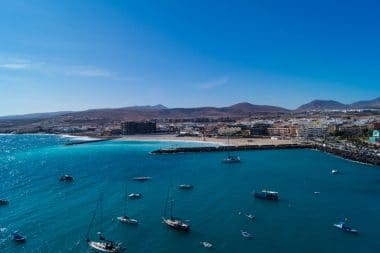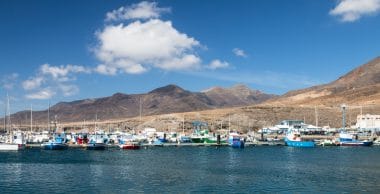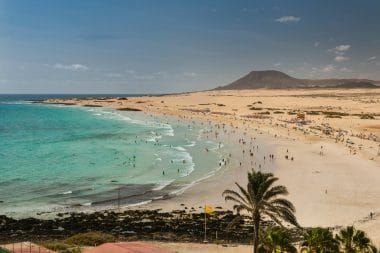Fuerteventura, one of the Canary Islands located in the Atlantic Ocean, is also known by its nickname “Island of Eternal Spring”. And that’s no wonder. Temperatures in Fuerteventura are mild all year round. In addition, around 300 days of sunshine are counted annually. This means that the volcanic island attracts a lot of beach holidaymakers. However, if you don’t go on a sightseeing tour or two through the enchanting and quaint small towns and villages of the island, you’re missing out.
The island’s capital Puerto del Rosario

Puerto del Rosario is a centrally located port city, and with about 41,000 inhabitants the capital of the island of Fuerteventura. Along the harbour promenade, interesting sculptures and works of art are lined up. The town centre is formed by whitewashed traditional Canarian houses. This is where the life of the island pulsates. Puerto del Rosario is not only the economic, but also the cultural center of Fuerteventura.
In the city there are some churches worth seeing, such as the Iglesia de Nuestra Señora del Rosario or the Iglesia Santo Domingo de Guzmán. The most famous inhabitant of the island was the writer and philosopher Miguel de Unamuno, who published novels, poetry and travel descriptions. The Casa Museo Miguel de Unamuno is dedicated to him. Miguel de Unamuno was originally from mainland Spain, but was exiled to the island in 1924. In the Ecomuseo La Alcogida, which can be found just a few kilometers outside Puerto del Rosario, the traditional rural life of Fuerteventura can be explored. The museum consists of a total of seven courtyards, which were built in traditional island architecture from natural stones from the immediate vicinity. Agricultural equipment, handicrafts and everyday necessities are exhibited in the courtyards. In the evening, the bars and clubs in downtown Puerto del Rosario open their doors and attract partygoers. Those who like it quieter can enjoy the picturesque beaches of the city, such as Playa Chica, which connects directly to the harbor.
In the old fishing village of Morro Jables

A visit to the fishing village of Morro Jables is one of the highlights of every Fuerteventura holiday. The town is located in the very south of the island, on the Jandia peninsula. The former fishing village is located in the middle of the Atlantic Ocean, picturesquely nestled between two rocky hills. The port of the village is very busy. Ferries to and from Las Palmas and Gran Canaria dock here. In the center of the town, a statue commemorates Cirilo López Umpiérrez, who founded the town in 1899. Until the 1970s, Morro Jables seemed like the end of the world. There was very little comfort in the village. For example, there was no telephone line back then. If you are looking for silence and seclusion, this is still the place for you today. Everything in Morro Jables seems a little out of time. On the adjacent Playa del Matorral, visitors can relax or indulge in water sports before enjoying freshly caught fish in one of the small restaurants at the harbour in the evening. The old town of the village looks enchanted and invites you to take a romantic walk at any time of the day.
Water Adventure and Desert Scenery in Corralejo

Things are much livelier at the northernmost tip of the island, in the town of Corralejo, which has a population of around 16,500. The city is known as a party hot spot because of its high density of clubs and bars all over the island. The historic old town is also popular for shopping. If you need a break from the hustle and bustle, take a detour to the protected dune landscape of El Jable, which is only a few hundred meters from the city center. The shifting dune of fine, light sand and shell limestone is constantly moving, and is therefore a natural spectacle. It is particularly recommended to visit during sunrise or sunset. Then you can take particularly romantic pictures here, which give the impression of being in the middle of a desert landscape. If you are looking for a real water pleasure in addition to sand and beach adventures, you should visit the Acua Water Park in Corralejo. Children in particular like to let off steam between water slides and water adventure landscapes.
Betancuria – Canarian history galore
The village of Betancuria has less than 800 inhabitants, and no access to the lake. Nevertheless, the place should not be left out during a Fuerteventura road trip. Flowers and palm trees bloom everywhere in the small village. The vegetation here is much richer than in many other places on the island, known as a desert island. The houses of the village shine white with terracotta-colored roofs. The small restaurants in the village look rustic: you won’t find tablecloths on the scratched wooden tables. Organic products from the region are served, such as grilled goat cheese and papas arrugadas – potatoes – with red mojo sauce. Betancuria was founded in 1404. In the local history museum Casa Museo de Betancuria, the history of the traditional village comes alive once again. Also worth seeing are the church of Santa Maria de Betancuria, built in 1410, and the Museo Arto Sacro art museum. With the Nuestra Señora de la Peña, which dates back to the 17th century, Betancuria even has a pilgrimage church. If you walk a few steps into nature on the outskirts of the village, you can look forward to magnificent views of Betancuria and the surrounding mountain landscape.


